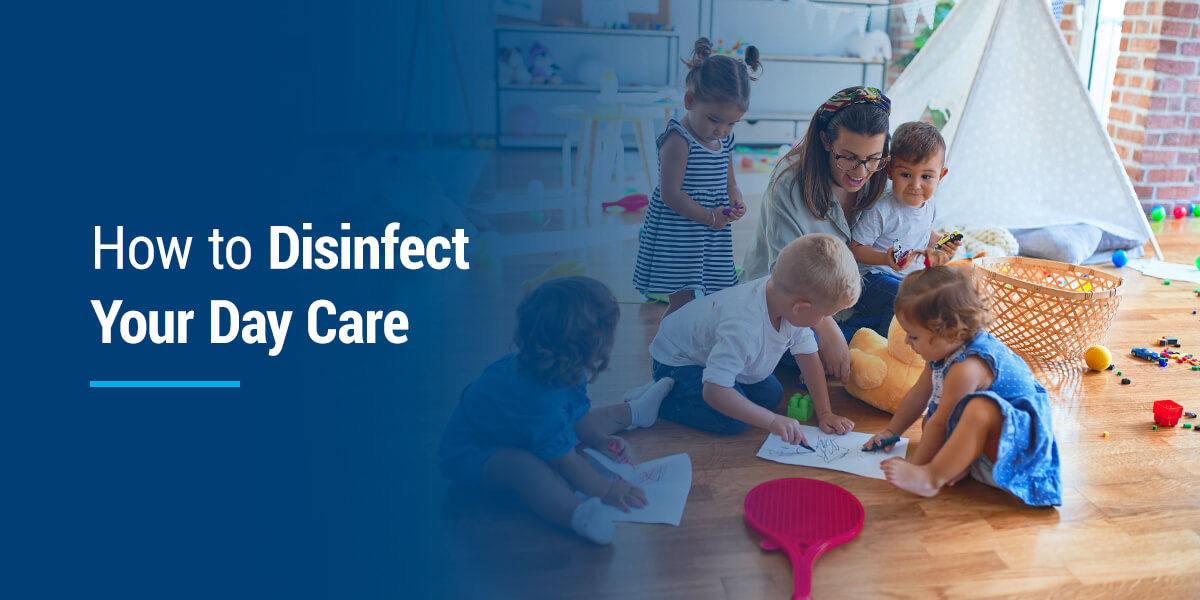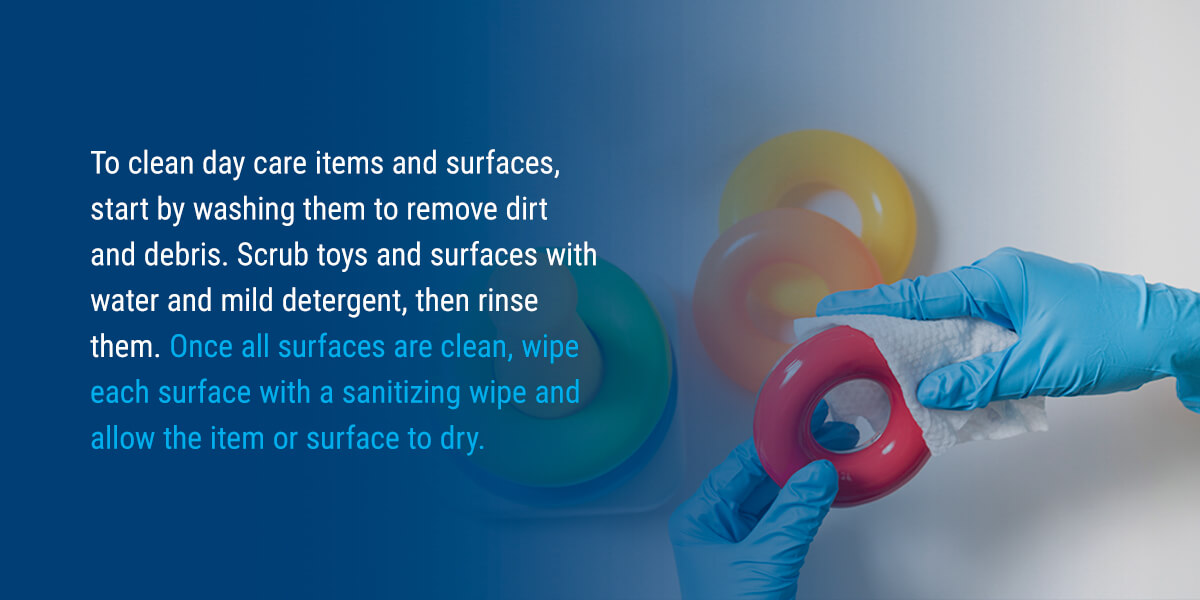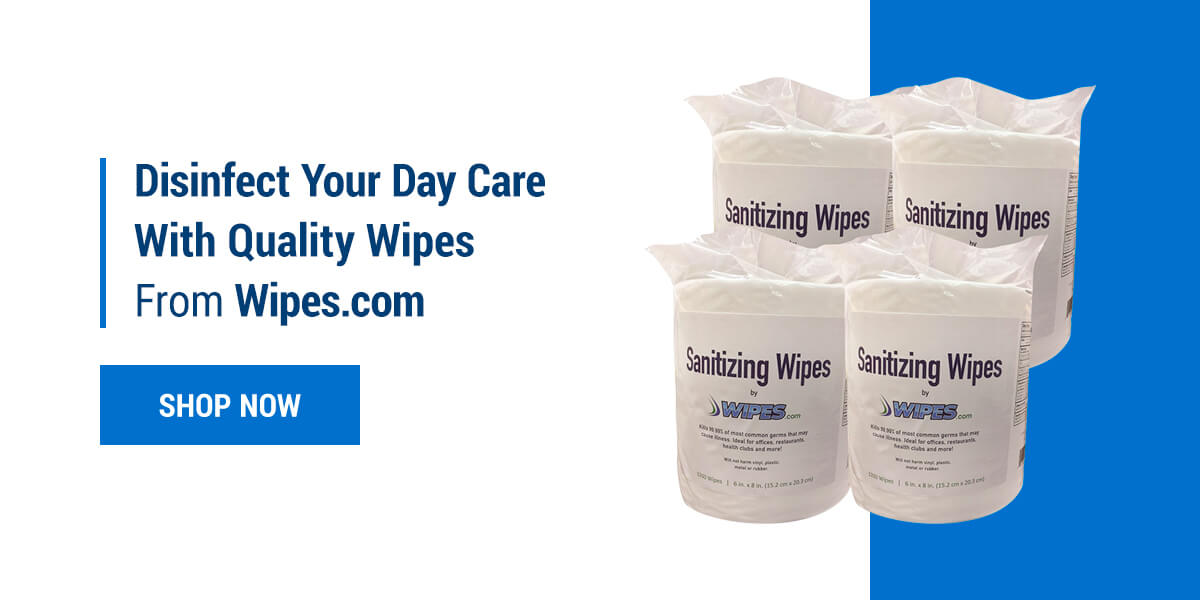Guide to Proper Day Care Disinfection | Wipes.com

Effective & Proper Day Care Disinfection
A day care center is a safe place for kids to play, sleep and eat throughout the day. While little ones are busy learning and having fun, they are also spreading germs, bacteria and viruses. Children are still learning proper hygiene and don't always understand how to prevent the spread of germs. They touch many surfaces throughout the day, creating opportunities to catch and spread illnesses.
An effective cleaning and disinfecting routine can help keep the kids in your child care center healthy. You can reduce the spread of bacteria, viruses and other germs by frequently and properly disinfecting your day care. Cleaning alone cannot eliminate germs, so it's important to kill bacteria and viruses with the proper products. Disinfecting your day care helps keep the children in your care safe and healthy by reducing the spread of germs that cause illnesses and infections.
What Is the Difference Between Cleaning, Sanitizing and Disinfecting?
Cleaning, sanitizing and disinfecting may sound like the same thing, but they are three different processes that produce different results. Each step is essential for keeping surfaces free of bacteria and viruses.
When children cough, sneeze or touch their mouths and noses before playing, they can transfer thousands of germs into the air and onto surfaces. This is why it's important to make sure you kill as many bacteria and viruses as possible to keep the little ones in your day care healthy. Cleaning alone doesn't kill the bacteria and viruses that cause illnesses and infections. To eliminate these pesky germs, you must also sanitize and disinfect surfaces.
Cleaning
When you clean a surface, you remove visible particles such as dirt, soil and dust from surfaces. Cleaning involves using soap, detergent or solvent along with a wipe or cloth. Cleaning is essential, but it does not completely eliminate viruses or bacteria from surfaces.
You should always clean a surface before sanitizing and disinfecting it because cleaning will improve each step's effectiveness. Cleaning gets dirt and debris out of the way so you can effectively sanitize and disinfect a surface.
Sanitizing
Sanitizing removes some bacteria from a surface, but it does not completely destroy or kill the bacteria. Instead, it reduces the number of bacteria present on a surface to a level that public health standards consider safe. Sanitizing wipes contain milder chemicals than disinfectants, so people often use sanitizers to clean food contact surfaces. If you are cleaning a food preparation surface, check the sanitizer label to ensure it is food safe. Sanitizing Wipes do not "kill" COVID-19. Only use EPA Registered Disinfecting Wipes if specific kill claims are required.
Disinfecting
Disinfecting is the process of killing or inactivating bacteria and viruses on a surface, and it's the most effective way to prevent infection and the spread of viruses and bacteria. Disinfectant wipes can kill the bacteria and viruses listed on their label, so it's important to always check labels to ensure your disinfectant wipes can kill most bacteria and viruses. Disinfecting wipes registered with the Environmental Protection Agency (EPA) can kill 99.9% of viruses and bacteria when used properly. Always rinse the surface you have disinfected as to protect you and your guests from contacting the disinfectant.
Important Areas to Clean
Child care centers have many areas that collect bacteria and germs throughout the day, so it's important to keep certain areas clean and sanitized. To keep the children in your care safe and healthy, make sure you clean, sanitize and disinfect the following surfaces:
- Toys
- Walls
- Sinks
- Toilets
- Tables
- Phones
- Railings
- Cubbies
- Counters
- Nap mats
- Keyboards
- Door handles
- Light switches
- Chairs and stools
- Drinking fountains
- Refrigerator handles
- Diaper changing areas
- Play surfaces and toy shelves
- Pencils and other writing tools
The most reliable way to keep your day care surfaces and items clean is to create a cleaning schedule. This means that you clean certain items and surfaces at certain times each day. Clean and disinfect surfaces that are visibly dirty immediately, especially if they are soiled with bodily fluids. You should also clean and disinfect diaper changing areas between each diaper change, even if they don't appear dirty.
You should clean and sanitize high chairs and table surfaces where children eat both before and after use. Additionally, you should clean and disinfect nap mats or cots each day after the children use them. This will ensure they are free of bacteria and viruses for the following day.
Clean and disinfect frequently touched surface areas daily, and try to complete toy cleaning for play centers weekly. Collect toys that children place in their mouths throughout the day, and clean and disinfect them at the end of each day to kill any bacteria or viruses that may be present on the surfaces. You should also immediately disinfect toys that come in contact with any bodily fluids.

How to Clean Day Care Items
To clean day care items and surfaces, start by washing them to remove dirt and debris. Scrub toys and surfaces with water and mild detergent, then rinse them. Once all surfaces are clean, wipe each surface with a sanitizing wipe and allow the item or surface to dry.
Finally, you can wipe each surface with a disinfectant wipe and allow it to dry or wipe it off according to the manufacturer's instructions. Leaving surfaces to air dry gives sanitizing and disinfecting chemicals time to kill bacteria and viruses effectively. Make sure you use sanitizing wipes approved by the Food and Drug Administration (FDA) to remove 99.9% of bacteria and EPA-registered disinfecting wipes.
If your day care has many toys to clean, you can also wash them in the dishwasher. Dishwashers use water at temperatures higher than your hands can handle. Clean electronics, battery-operated toys and porous toys with disinfectant wipes to avoid damaging them.
Disinfect Your Day Care With Quality Wipes From
Wipes.com
Germs can spread quickly in day care centers as children play, eat, sleep and receive care close to each other. Surfaces collect bacteria and viruses throughout the day, creating opportunities for little ones to catch illnesses and infections. You can prevent germs from spreading with an effective cleaning and disinfecting routine.
Keep the children in your care safe and healthy with quality sanitizing and disinfecting wipes. Whether you operate a large day care center or a small home day care, it's critial to disinfect surfaces frequently to prevent the spread of germs. Cleaning alone does not kill bacteria and viruses, so you must use the correct disinfecting products to eliminate them fully.
Disinfect your day care with quality wipes from Wipes.com. We carry FDA-approved sanitizing wipes and EPA-registered disinfecting wipes so you can kill bacteria and viruses on your day care center's surfaces. You can conveniently purchase bulk orders of wipes to keep your day care center stocked. We also offer Wipes Dispenser such as wall mount dispensers, standing dispensers and dispensing buckets. Shop Wipes.com to purchase quality disinfecting and sanitizing wipes for your day care.
Recent Posts
-
How to Sell Gym Memberships Effectively (and Why a Clean Facility is Your Secret Weapon)
Introduction: The New Age of Fitness Membership Sales Selling gym memberships is no longer about ju …12th May 2025 -
The Clean Office Advantage
The Clean Office Advantage: How a Tidy Workplace Boosts Productivity, Happiness, and Safety In today …16th Apr 2025 -
Jake and Lisa discuss H1N1 vs H5N1...
Jake: Hey, Lisa! I was just reading about influenza viruses, and I came across H1N1 and H5N1. I know …6th Feb 2025
